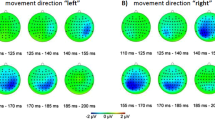Abstract
Motion-onset visual evoked potentials were studied in 140 subjects by means of motion-onset stimulation either on a television screen or through back projecting via a moving mirror. The motion-onset visual evoked potentials were characterized in 94% of the population by a dominant negative peak with latency in the range of 135–180 ms. Motion-onset visual evoked potentials with a dominant positive peak, as described in the literature, seemed to be a variant of pattern-off visual evoked potentials, caused by the pattern-disappearance effect at the onset of motion with a high temporal frequency (the multiple of the spatial frequency of the structure and the velocity of motion) of more than 6 Hz. Such visual evoked potentials occur mainly when the stimulus is limited to the macular area only. Additionally, other stimulus and recording conditions were found to be suitable for acquiring the specific motion-onset potentials without their contamination by pattern-related components. These conditions were as follows: an aperiodic moving pattern (e.g., random dots) with a low contrast (<0.2); a short duration of motion (⩽200 ms) and a sufficient interstimulus interval (at least five times longer than the motion duration) to decrease the adaptation to motion; and extramacular stimulation and recording of visual evoked potentials from unipolar lateral occipital leads. Such leads should be used because of the lateralization of these visual evoked potentials (mainly to the right occipital area), which is consistent with their assumed extrastriate origin.
Similar content being viewed by others
Abbreviations
- TF:
-
temporal frequency
References
Finlay D. Motion perception in the peripheral visual field. Perception 1982; 11: 457–62.
Hunzelmann N, Spillmann L. Movement adaptation in the peripheral retina. Vision Res 1984; 24: 1765–9.
de Monasterio FM, Gouras P. Functional properties of ganglion cells of the rhesus monkey retina. J Physiol 1975; 251: 167–95.
Derrington AM, Lennie P. Spatial and temporal contrast sensitivities of neurones in lateral geniculate nucleus of macaque. J Physiol 1984; 357: 219–40.
Kaplan E, Lee BB, Shapley RM. New views of primate retinal function. In: Osborne N, Chader J, eds. Progress in retinal research, Vol. 9. Oxford: Pergamon Press, 1990: 273–336.
Lennie P, Trevarthen C, van Essen D, Wässle H. Parallel processing of visual information. In: Spillmann L, Werner JS, eds. Visual perception: The neurophysiological foundations. San Diego: Academic Press, 1990: 103–28.
Kubová Z, Kuba M, Vít F, Hubácek J, Vít F. Properties of visual evoked potentials to onset of movement on a television screen. Doc Ophthalmol 1990; 75: 67–72.
Yokoyama M, Matsunaga I, Yonekura Y, Shinzato K. The visual evoked response to moving pattern. In: Proceedings of the 16th ISCEV Symposium, Morioka. 1979: 207–14.
Göpfert E, Müller R, Markwardt F, Schlykowa L. Visuell evozierte Potentiale bei Musterbewegung. Z EEG-EMG 1983; 14: 47–51.
Spekreijse H, Dagnelie G, Maier J, Regan D. Flicker and movement constituents of the pattern reversal response. Vision Res 1985; 25: 1297–304.
Dagnelie G. Pattern and motion processing in primate visual cortex [Thesis]. Amsterdam: University of Amsterdam, 1986.
De Vries M, Van Dijk B, Spekreijse H. Motion onset-offset VEPs in children. Electroencephalogr Clin Neurophysiol 1989; 74: 81–7.
Kubová Z, Kuba M. Clinical application of motion-onset VEPs. In: Proceedings of the 29th ISCEV Symposium, Oxford. 1991: 65.
Newsome WT, Paré EB. A selective impairment of motion perception following lesions of the middle temporal visual area (MT). J Neurosci 1988; 8: 2201–11.
Zeki S. A theory of multi-stage integration in the visual cortex. In: Eccles JC, Creutzfeldt O, eds. The principles of design and operation of the brain. Berlin: Springer Verlag, 1990: 137–54.
Author information
Authors and Affiliations
Rights and permissions
About this article
Cite this article
Kuba, M., Kubová, Z. Visual evoked potentials specific for motion onset. Doc Ophthalmol 80, 83–89 (1992). https://doi.org/10.1007/BF00161234
Accepted:
Issue Date:
DOI: https://doi.org/10.1007/BF00161234




